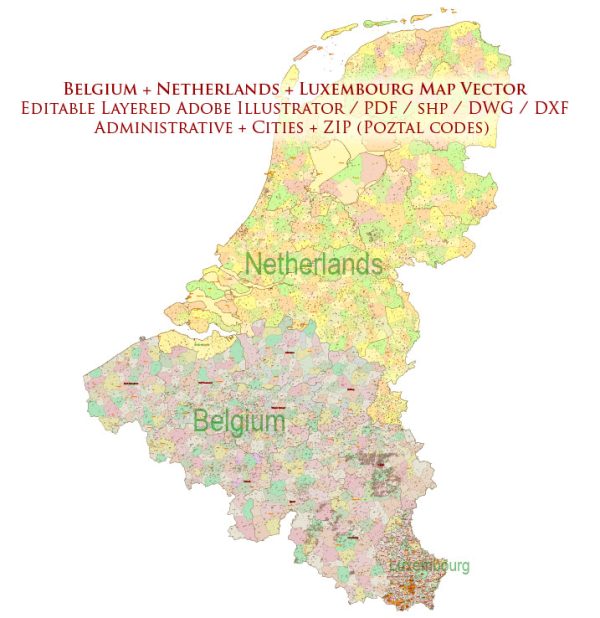A general overview of the transportation infrastructure in Belgium, the Netherlands, and Luxembourg.
Vectormap.Net provide you with the most accurate and up-to-date vector maps in Adobe Illustrator, PDF and other formats, designed for editing and printing. Please read the vector map descriptions carefully.
Belgium:
- Road Transportation:
- Belgium has an extensive road network, with well-maintained highways and roads.
- The road system is a crucial component of both domestic and international transportation, given Belgium’s central location in Europe.
- Brussels, the capital, serves as a major hub for road connections.
- Rail Transportation:
- Belgium has a well-developed and efficient railway network managed by the National Railway Company of Belgium (SNCB/NMBS).
- High-speed rail connections, such as the Thalys and Eurostar, link Belgium with neighboring countries.
- Air Transportation:
- Brussels Airport, located in Zaventem, is a major international airport and serves as a key air transportation hub for Belgium.
- Charleroi Airport is another significant airport, mainly used by low-cost carriers.
- Ports:
- Belgium has several major ports, with the Port of Antwerp being one of the largest and busiest in Europe. It plays a crucial role in international trade.
Netherlands:
- Road Transportation:
- The Netherlands boasts a well-developed road network, including an extensive system of highways and well-maintained roads.
- Rotterdam and Amsterdam are key cities that serve as major transportation hubs.
- Rail Transportation:
- The Dutch railway system is extensive and efficient, managed by Nederlandse Spoorwegen (NS).
- High-speed trains connect the Netherlands with neighboring countries, providing quick and convenient international travel options.
- Air Transportation:
- Amsterdam Airport Schiphol is one of the busiest and most well-connected airports in Europe. It serves as a major international hub for air travel.
- Ports:
- The Port of Rotterdam is one of the largest and busiest ports in the world, playing a vital role in European and global maritime trade.
Luxembourg:
- Road Transportation:
- Luxembourg has a well-maintained road network, connecting the country with its neighbors.
- The road system is crucial for both domestic travel and as part of international routes.
- Rail Transportation:
- The Luxembourg railway network is relatively small but efficient. It is managed by Chemins de Fer Luxembourgeois (CFL).
- Air Transportation:
- Luxembourg Findel Airport serves as the main international airport. While not as large as some neighboring airports, it plays a significant role in air cargo transport.
- Inland Waterways:
- The Moselle River is an essential waterway for Luxembourg, supporting both transportation and tourism.
Overall, the Benelux countries (Belgium, Netherlands, and Luxembourg) benefit from their central location in Europe, with well-developed transportation infrastructure facilitating smooth movement of goods and people within the region and to other parts of the continent.


 Author: Kirill Shrayber, Ph.D.
Author: Kirill Shrayber, Ph.D.